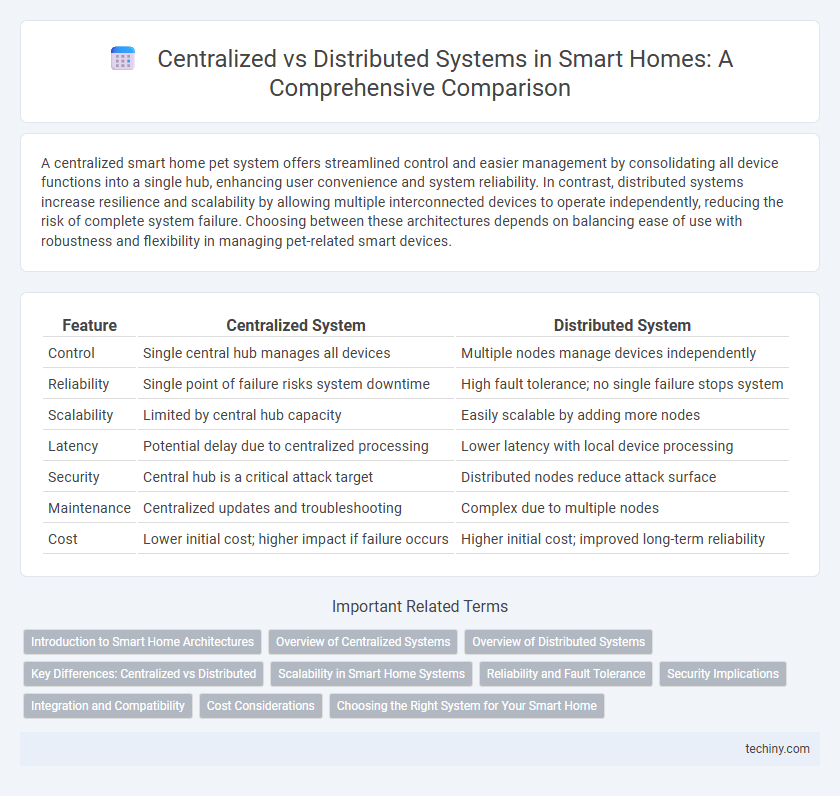A centralized smart home pet system offers streamlined control and easier management by consolidating all device functions into a single hub, enhancing user convenience and system reliability. In contrast, distributed systems increase resilience and scalability by allowing multiple interconnected devices to operate independently, reducing the risk of complete system failure. Choosing between these architectures depends on balancing ease of use with robustness and flexibility in managing pet-related smart devices.
Table of Comparison
| Feature | Centralized System | Distributed System |
|---|---|---|
| Control | Single central hub manages all devices | Multiple nodes manage devices independently |
| Reliability | Single point of failure risks system downtime | High fault tolerance; no single failure stops system |
| Scalability | Limited by central hub capacity | Easily scalable by adding more nodes |
| Latency | Potential delay due to centralized processing | Lower latency with local device processing |
| Security | Central hub is a critical attack target | Distributed nodes reduce attack surface |
| Maintenance | Centralized updates and troubleshooting | Complex due to multiple nodes |
| Cost | Lower initial cost; higher impact if failure occurs | Higher initial cost; improved long-term reliability |
Introduction to Smart Home Architectures
Smart home architectures leverage either centralized systems, where a single hub manages all devices, or distributed systems, which allocate control across multiple interconnected nodes to enhance reliability and scalability. Centralized systems simplify device management and programming but may create single points of failure, whereas distributed systems improve fault tolerance and enable localized decision-making for real-time responsiveness. Understanding the trade-offs between these architectures is crucial for designing efficient, secure, and user-friendly smart home environments.
Overview of Centralized Systems
Centralized smart home systems rely on a single control hub that manages all connected devices, enabling streamlined automation and easier system management. These systems offer enhanced security through unified monitoring and simplify troubleshooting by consolidating data and controls in one interface. Centralized systems are ideal for homeowners seeking straightforward installation and centralized oversight of lighting, climate, security, and entertainment devices.
Overview of Distributed Systems
Distributed systems in smart home environments consist of multiple interconnected devices that operate independently yet collaboratively, enhancing reliability and scalability. Each device processes data locally, reducing latency and bottlenecks commonly associated with centralized control, thereby improving responsiveness and fault tolerance. This decentralized architecture enables seamless integration of diverse smart home components like lighting, security, and HVAC systems, optimizing overall performance and user experience.
Key Differences: Centralized vs Distributed
Centralized smart home systems rely on a single control unit that manages all connected devices, offering streamlined management but posing a risk of total system failure if the central hub malfunctions. Distributed systems decentralize control among multiple nodes, enhancing reliability and scalability by allowing devices to operate independently even if one node fails. Key differences include centralized systems' simplified setup and management contrasted with distributed systems' improved fault tolerance and flexibility.
Scalability in Smart Home Systems
Centralized systems in smart homes offer straightforward control but face limitations in scalability as adding devices increases load on the central hub, potentially causing latency and failure points. Distributed systems enhance scalability by decentralizing control, allowing multiple devices or nodes to operate independently and communicate locally, effectively managing larger networks without centralized bottlenecks. This architecture supports seamless integration of numerous smart devices, improving system resilience and accommodating future expansion in smart home environments.
Reliability and Fault Tolerance
Centralized smart home systems rely on a single control unit, which presents a point of failure that can disrupt the entire network's operation. Distributed systems enhance reliability by decentralizing control across multiple devices, allowing the system to maintain functionality even if individual nodes fail. This fault tolerance mechanism ensures continuous operation and improves overall system resilience in smart home environments.
Security Implications
Centralized Smart Home systems store data and control in a single hub, which can simplify security management but create a single point of failure vulnerable to hacking. Distributed Smart Home systems enhance security by decentralizing control and data storage across multiple devices, reducing risk if one node is compromised. Encryption, multi-factor authentication, and regular firmware updates are critical security measures in both architectures to protect against cyber threats.
Integration and Compatibility
Centralized smart home systems offer seamless integration by managing all devices through a single control hub, ensuring consistent compatibility across various brands and protocols. Distributed systems rely on multiple interconnected nodes, which can enhance flexibility but may face challenges in standardizing communication and device interoperability. Effective smart home integration requires balancing centralized management for uniform compatibility with the distributed architecture's scalability and redundancy.
Cost Considerations
Centralized smart home systems often incur higher upfront costs due to the need for a primary control unit and professional installation, but they may reduce long-term expenses through streamlined maintenance. Distributed systems typically offer lower initial investment and greater scalability by using multiple autonomous devices, though ongoing management can increase operational costs. Evaluating total cost of ownership, including installation, maintenance, and future expansion, is crucial when choosing between centralized and distributed smart home architectures.
Choosing the Right System for Your Smart Home
Selecting the right system for your smart home depends on your specific needs for control and scalability. Centralized systems offer streamlined management through a single hub, ideal for simpler setups and ease of use, while distributed systems provide enhanced reliability and flexibility by allowing devices to operate independently. Evaluating factors such as network size, device compatibility, and desired level of automation ensures optimal performance and future-proofing for your smart home environment.
Centralized System vs Distributed System Infographic

 techiny.com
techiny.com